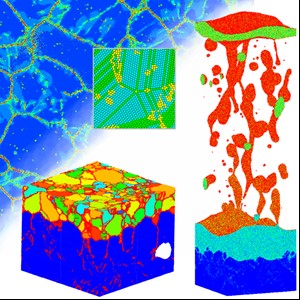Freitag, 16. Dezember 2016, 15:15 - 16:45 iCal
MATERIALS SCIENCE SEMINAR
"Large-scale atomistic simulations of material modification by short laser pulses and optically induced surface acoustic waves"
Gastvortrag von Prof. Dr. Leonid Zhigilei (University of Virginia, Department of Materials Science and Engineering, Charlottesville, VA, USA)
Universität Wien, Chemische Institute, Seminar Raum 2 (Raum 2124), 1. Stock
Währinger Straße 42, 1090 Wien
Vortrag
Atomistic and coarse grained molecular dynamics (MD) simulations of laser-materials interactions are playing an increasingly important role in investigation of complex and highly non-equilibrium processes involved in short pulse laser processing of materials and surface modification. This role is defined by the ability of MD simulations to reveal the microscopic mechanisms of structural and phase transformations induced by the laser excitation and, at the same time, to provide clear visual representations, or “atomic movies,” of laser-induced dynamic processes. In this presentation, an overview of recent results of large-scale MD simulations of the direct laser-induced modification of surface morphology and microstructure in metals, as well as the acoustically-induced activation of surface processes at a substantial distance from the irradiated laser spot, will be provided. In the case of the direct laser modification of metal targets, the processes responsible for the formation of a sub-surface porous region covered by a nanocrystalline surface layer with random crystallographic orientation of nanograins and a high density of stacking faults, twins, and nanoscale twinned structural elements with five-fold symmetry will be discussed and related to the experimental observations of surface swelling, growth twinning, and incubation effect in multi-pulse laser ablation [1-4].
For the acoustic activation of surface processes, the conditions leading to the maximum enhancement of surface diffusion are analyzed and explained by nonlinear wave profile sharpening leading to efficient generation of high-frequency harmonics that directly couple to the vibrational modes of surface species [5]. The implications of the computational predictions for the design of new techniques where the acoustic energy serves as an effective substitution for thermal activation of surface processes are discussed.
The illustration represents of some of the results of atomistic modeling of structural modification of Ag targets irradiated by 200 fs laser pulses
[1] C. Wu et al., Phys. Rev. B 91, 035413, 2015.
[2] C. Wu and L. V. Zhigilei, J. Phys. Chem. C 120, 4438-4447, 2016.
[3] X. Sedao et al., ACS Nano 10, 6995-7007, 2016.
[4] www.faculty.virginia.edu/CompMat/laser-surface-nanostructuring/
[5] M. V. Shugaev et al., Phys. Rev. B 91, 235450, 2015.
Veranstalter
Institut für Physikalische Chemie, Universität Wien
Kontakt
Univ.-Prof. Dr. Wolfgang Kautek
Universität Wien
Institut für Physikalische Chemie
0043 664 60277 52470
wolfgang.kautek@univie.ac.at
Erstellt am Mittwoch, 09. November 2016, 00:27
Letzte Änderung am Montag, 14. November 2016, 08:35

